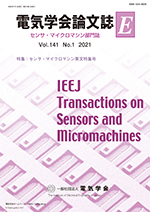
- |<
- <
- 1
- >
- >|
-
―― 特集号によせて ――二川 雅登2021 年 141 巻 11 号 p. 366
発行日: 2021/11/01
公開日: 2021/11/01
ジャーナル 認証あり近年の急激な気象変動に対応するため,農業分野では持続可能な農業の推進が求められ,温度や日射量などのオンサイトモニタリングによるデータ収集やエビデンスに基づくサポートが必要となっている。また,環境分野では防災・減災,国土強靱化のため,オンサイトモニタリングによる
抄録全体を表示PDF形式でダウンロード (195K)
-
大河原 誠一, 三浦 健太郎, 平野 陽豊, 大多 哲史, 二川 雅登2021 年 141 巻 11 号 p. 367-372
発行日: 2021/11/01
公開日: 2021/11/01
ジャーナル 認証ありIn recent years, the demand for highly nutritious and functional vegetables has been increasing in the agricultural sector. In order to cultivate highly functional vegetables, it is necessary to adjust the nutrients in the soil, such as potassium ions, to an optimal state. Therefore, there is a need for a sensor that can measure soil ion concentration in real time in the field. In this report, we aim to develop an ion concentration sensor using NMR (Nuclear Magnetic Resonance). Since the sensor observes atomic specific behavior, it has the potential to measure the concentration of each ion species in soil where multiple ions exist.
In this laboratory, we aim to realize compact NMR and to establish a method for NMR measurement of water ahead of ion measurement. Using an NMR measurement system of our own design, we measured water and air. As a result, NMR signal spectra were obtained only when measuring water under resonance conditions, and resonance frequency of hydrogen atoms were successfully measured. We have established an NMR signal measurement method for measuring ion concentrations using a small NMR sensor that can be installed in the agriculture.
抄録全体を表示PDF形式でダウンロード (1315K) -
Hidekazu Ito2021 年 141 巻 11 号 p. 373-377
発行日: 2021/11/01
公開日: 2021/11/01
ジャーナル 認証ありThe nitrate ion content of vegetables is important from the viewpoint of food safety. There is a weak absorption band (π*←n electric transition) of nitrate ions at 302 nm spanning from 272 nm to 332 nm and this absorption band may be useful for the nondestructive determination of the nitrate ion content of leafy vegetables that have high nitrate ions concentration. Therefore, the objective of this study is to evaluate the potential of nondestructive determination method for the nitrate ion content of the leaf stalk of pak-choi (Brassica campestris L. chinensis group) by ultraviolet (UV) spectroscopy that measures the π*←n electric transition. Partial least squares (PLS) regression analyses of spectra (301-399 nm) of the leaf stalks of pak-choi (number of samples (n) = 108) showed a correlation coefficient of calibration (R cal.) of 0.90 and a standard error of calibration (SEC) of 775 ppm. The calibration was cross-validated and showed a correlation coefficient of validation (R val.) of 0.87 and a standard error of cross-validation (SECV) of 874 ppm. No large difference of more than 3000 ppm between the reference and nondestructively UV-estimated values of nitrate ions was observed in pak-choi samples even at lowest nitrate ion content, those harvested in autumn, as compared with the visible (VIS) - near infrared (NIR) method. The variable importance for projection (VIP) value which indicates the importance of independent variables was highest at 301 nm. The powder of KNO3 was also measured to confirm its absorption band. On the other hand, no obvious peaks were found in the VIS to short NIR region. Thus, the absorbance at around 301 nm shows that the absorption of nitrate ions contributed markedly to the nondestructive determination.
抄録全体を表示PDF形式でダウンロード (414K) -
角谷 友輝, 安藤 毅2021 年 141 巻 11 号 p. 378-385
発行日: 2021/11/01
公開日: 2021/11/01
ジャーナル 認証ありWe are attempting to establish an evaluating and monitoring method of photosynthesis using bioelectric potential of plants. In this study, we focused on a rapid biopotential response caused by the photochemical reaction in the first and speedy part of photosynthetic reactions. We propose an active method to evaluate intensity of the photochemical reaction that controls photosynthetic rate by using a frequency response of biopotential to blinking illumination. We have investigated the relation between the frequency responses of biopotential and the intensity of the photochemical reaction evaluated by a chlorophyll fluorescence measurement of leaves. The results showed that the frequency responses of biopotential to blinking illumination correlated with the amount of photon absorption calculated from the quantum yield by the chlorophyll fluorescence measurement. Finally, we concluded that the blinking illumination induced the rapid biopotential response that was mainly attributed to the photochemical reaction. Therefore, our proposed method could be available to evaluate the photosynthetic rate with higher accuracy than conventional method using bioelectric potential response of plants.
抄録全体を表示PDF形式でダウンロード (1019K)
-
Yoshiyuki Hashimoto, Masaho Kanou, Satoko Takase, Youichi Shimizu2021 年 141 巻 11 号 p. 386-387
発行日: 2021/11/01
公開日: 2021/11/01
ジャーナル 認証ありA potentiometric solid-state sensor using a Na5DySi4O12 solid-electrolyte and oxide electrodes was tried to examine for monitoring HCl gas. Among the oxides tested, the sensor using RuO2 electrode showed relatively good HCl response at 400°C. The electromotive force was almost linear to the logarithm of HCl concentration between 100 and 1000 ppm. This HCl sensor showed also good selectivity to CO2, NO, and NO2, and few effect of oxygen. A mixed potential sensing mechanism is tentatively proposed.
抄録全体を表示PDF形式でダウンロード (291K)
-
室山 真徳2021 年 141 巻 11 号 p. NL11_1
発行日: 2021/11/01
公開日: 2021/11/01
ジャーナル フリーPDF形式でダウンロード (869K) -
永井 萌土2021 年 141 巻 11 号 p. NL11_2
発行日: 2021/11/01
公開日: 2021/11/01
ジャーナル フリーPDF形式でダウンロード (128K) -
式田 光宏2021 年 141 巻 11 号 p. NL11_3-NL11_4
発行日: 2021/11/01
公開日: 2021/11/01
ジャーナル フリーPDF形式でダウンロード (423K) -
2021 年 141 巻 11 号 p. NL11_5
発行日: 2021/11/01
公開日: 2021/11/01
ジャーナル フリーPDF形式でダウンロード (212K)
-
2021 年 141 巻 11 号 p. L11_1
発行日: 2021/11/01
公開日: 2021/11/01
ジャーナル フリーPDF形式でダウンロード (120K)
- |<
- <
- 1
- >
- >|